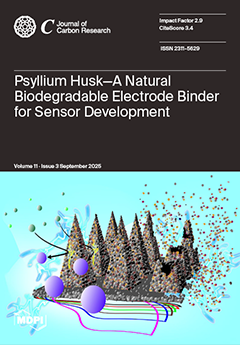The potential of king grass biomass as a precursor for carbon-based materials was evaluated through comprehensive physicochemical characterization. The biomass showed high fixed carbon content, reactive oxygenated groups, and favorable atomic ratios, supporting its suitability for conversion into porous carbon structures. This study
[...] Read more.
The potential of king grass biomass as a precursor for carbon-based materials was evaluated through comprehensive physicochemical characterization. The biomass showed high fixed carbon content, reactive oxygenated groups, and favorable atomic ratios, supporting its suitability for conversion into porous carbon structures. This study focused on the synthesis of graphene-like materials via high-temperature pyrolysis (~1000 °C), employing FeCl
3 and potassium ferricyanide (K
3[Fe(CN)
6]) as catalytic agents. Although FeCl
3 is widely studied, it showed limited capacity to promote graphitic ordering. In contrast, K
3[Fe(CN)
6] exhibited a synergistic effect, combining iron-based catalytic species (Fe, Fe
3C) and potassium-derived activating compounds (K
2CO
3), which significantly enhanced graphitization and porosity. Characterization by Raman spectroscopy, XRD, and SEM confirmed that materials synthesized with K
3[Fe(CN)
6] presented improved crystallinity, lower defect densities (I
D/I
G = 0.37–1.11), and distinct 2D bands (I
2D/I
G = 0.32–0.80), indicating the formation of few-layer graphene domains. The most promising structure was obtained from cellulose treated with alkaline peroxide and deoxygenated prior to pyrolysis with K
3[Fe(CN)
6], showing properties comparable to commercial graphene. BET analysis revealed surface areas up to 714.50 m
2/g. While non-catalyzed samples yielded higher mass, the catalytic approach with K
3[Fe(CN)
6] demonstrates a sustainable and efficient pathway for producing graphene-like carbon materials from lignocellulosic biomass.
Full article





